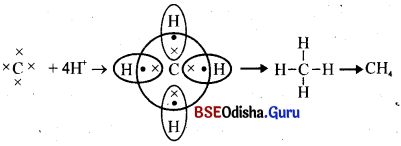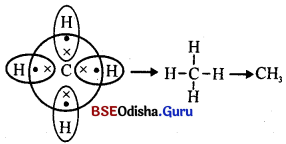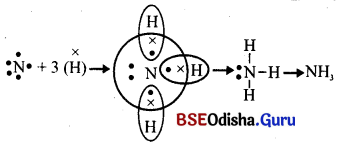Odisha State Board BSE Odisha 10th Class Political Science Important Questions Chapter 6 ଭାରତ ଓ ତାହାର ପଡ଼ୋଶୀ ରାଷ୍ଟ୍ର Important Questions and Answers.
BSE Odisha Class 10 Political Science Important Questions Chapter 6 ଭାରତ ଓ ତାହାର ପଡ଼ୋଶୀ ରାଷ୍ଟ୍ର
Subjective Type Questions With Answers
ଦୀର୍ଘ ଉତ୍ତରମୂଳକ ପ୍ରଶ୍ନୋତ୍ତର
ପ୍ରତ୍ୟେକ ପ୍ରଶ୍ନର ଉତ୍ତର ପ୍ରାୟ ୩୦ ଗୋଟି ଶବ୍ଦରେ ଲେଖ ।
୧। କୋରିଆ ଯୁଦ୍ଧ କାହିଁକି ସଂଘଟିତ ହୋଇଥିଲା ଓ ଏଥିରେ ଭାରତର ଆଭିମୁଖ୍ୟ କ’ଣ ଥିଲା ?
Answer:
- ଦ୍ବିତୀୟ ବିଶ୍ୱଯୁଦ୍ଧ ପରେ କୋରିଆ ଦୁଇ ଭାଗରେ ବିଭକ୍ତ ହୋଇଥିଲା ।
- ଉତ୍ତର କୋରିଆରେ କମ୍ୟୁନିଷ୍ଟ ଶାସନ ପ୍ରତିଷ୍ଠିତ ହୋଇ ସୋଭିଏତ୍ ରୁଷିଆର ସହଯୋଗ ଲାଭ କଲା ଏବଂ ଦକ୍ଷିଣ କୋରିଆରେ ଯୁକ୍ତରାଷ୍ଟ୍ର ଆମେରିକା ସମର୍ଥିତ ଶାସନ ବ୍ୟବସ୍ଥା ପ୍ରତିଷ୍ଠା ହେଲଶ ।
- ୧୯୪୯ ମସିହାରେ ଉତ୍ତର କୋରିଆ ବିରୋଧରେ ଦକ୍ଷିଣ କୋରିଆକୁ ଯୁକ୍ତରାଷ୍ଟ୍ର ଆମେରିକା ସମର୍ଥନ ଦେଲା, ଫଳସ୍ବରୂପ କୋରିଆ ଯୁଦ୍ଧ ସଂଘଟିତ ହେଲା ।
- ଯୁକ୍ତରାଷ୍ଟ୍ର ଆମେରିକାର ଏହି ପଦକ୍ଷେପକୁ ଭାରତ ନିନ୍ଦା କରିଥିଲା, ଫଳତଃ ଯୁକ୍ତରାଷ୍ଟ୍ର ଆମେରିକା ଭାରତ ବିରୋଧୀ ପଡ଼ୋଶୀ ରାଷ୍ଟ୍ର ପାକିସ୍ତାନକୁ ସହଯୋଗ ଓ ସମର୍ଥନ ଜଣାଇଥିଲା ।
୨। ଭାରତର ବୈଦେଶିକ ନୀତିର ବୈଶିଷ୍ଟ୍ୟଗୁଡ଼ିକ କ’ଣ ଥିଲା ?
Answer:
- ଭାରତ ଗୋଷ୍ଠୀନିରପେକ୍ଷତା ନୀତିରେ ବିଶ୍ୱାସ କରେ । ଆନ୍ତଃରାଷ୍ଟ୍ରୀୟ ସମାଜକୁ ଏହା ଭାରତର ମୁଖ୍ୟ ଅବଦାନ । ଭାରତ ‘ବସୁଧୈବ କୁଟୁମ୍ବକମ୍’ ନୀତିର ବିଶ୍ୱର କରେ । ବିଶ୍ୱର ସମସ୍ତ ରାଷ୍ଟ୍ର ଶାନ୍ତି ଓ ମୈତ୍ରୀର ସୌହାର୍ଘ୍ୟପୂର୍ଣ ବାତାବରଣ ମଧ୍ଯରେ ଚଳନ୍ତୁ – ଏହା ଥିଲା ଭାରତର ଇଚ୍ଛା ।
- ଭାରତ ଉପନିବେଶବାଦ ଓ ସାମ୍ରାଜ୍ୟବାଦର ଘୋର ବିରୋଧୀ ଅଟେ ତଥା ପ୍ରତ୍ୟେକ ମନୁଷ୍ୟର ସମାନତା ଓ ସ୍ଵାଧୀନତାଜନିତ ଅଧିକାରରେ ଭାରତ ବିଶ୍ଵାସ କରେ ।
- ଆର୍ଥିକ ସହାୟତା ଯୋଗାଇବା ମାଧ୍ୟମରେ ଗରିବ ରାଷ୍ଟ୍ରମାନଙ୍କୁ ଶୋଷଣ କରିବାର ଅଭିପ୍ରାୟକୁ ଭାରତ ଘୃଣା କରେ । ବିଶ୍ୱ ଶାନ୍ତିପ୍ରତିଷ୍ଠା ଦିଗରେ ସଂଯୁକ୍ତ ରାଷ୍ଟ୍ରସଂଘର ସମସ୍ତ ଉଦ୍ୟମକୁ ଭାରତ ସର୍ବଦା ସମର୍ଥନ କରି ଆସୁଅଛି ଓ ସହଯୋଗ ଦେଇ ଆସୁଅଛି । ଦେଶ ଦେଶ ମଧ୍ୟରେ କନ୍ଦଳ ଏକ ସ୍ବାଭାବିକ ଘଟଣା ହେଲେ ମଧ୍ୟ ଭାରତ ଏହି କନ୍ଦଳର ଶାନ୍ତିପୂର୍ଣ୍ଣ ସମାଧାନରେ ବିଶ୍ଵାସ କରେ ।
୩ । ଭାରତ ଓ ପାକିସ୍ତାନ ସମ୍ପର୍କରେ ଉନ୍ନତି ଆଣିବାପାଇଁ ଭାରତ କି ପ୍ରକାର ପଦକ୍ଷେପମାନ ଗ୍ରହଣ କରିଛ ?
Answer:
- ଉଭୟ ଦେଶର ସମ୍ପର୍କରେ ଉନ୍ନତି ଆଣିବାପାଇଁ ବାଜପାୟୀ ସରକାର ୧୯୯୯ରେ ଉଭୟ ଦେଶ ମଧ୍ୟରେ ବସ୍ ଚଳାଚଳ କରାଇବାପାଇଁ ନିଷ୍ପତ୍ତି ନେଇଥିଲେ ।
- ଉଭୟ ଦେଶ ମଧ୍ୟରେ କ୍ରିକେଟ୍, ହକି ଇତ୍ୟାଦି ଖେଳର ଆୟୋଜନ କରାଯାଇ ତାହା ମାଧ୍ୟମରେ ଉଭୟ ଦେଶର ସମ୍ପର୍କରେ ଉନ୍ନତି ଆଣିବାପାଇଁ ଉଦ୍ୟମ ଜାରିରହିଛି ।
- ଭାରତ ସର୍ବଦା ପାକିସ୍ତାନ ସହ ବନ୍ଧୁତ୍ଵପୂର୍ଣ୍ଣ ସମ୍ପର୍କ ପ୍ରତିଷ୍ଠା ପାଇଁ ଗଠନମୂଳକ ଉଦ୍ୟମ ଜାରି ରଖିଛି ।
![]()
୪।. କାଶ୍ମୀର ପ୍ରସଙ୍ଗରେ ସୋଭିଏତ୍ ରୁଷିଆର ଦୃଷ୍ଟିଭଙ୍ଗୀ କ’ଣ ଥିଲା ?
Answer:
- କାଶ୍ମୀରକୁ ନେଇ ଭାରତ ଓ ପାକିସ୍ତାନ ମଧ୍ୟରେ ଉପୁଜିଥିବା ବିବାଦରେ ସୋଭିଏତ୍ ରୁଆ ଭାରତକୁ ସମର୍ଥନ କରିଥିଲା । କାଶ୍ମୀର ଭାରତର ଅବିଚ୍ଛେଦ୍ୟ ଅଙ୍ଗ ବୋଲି ସୋଭିଏତ୍ ରୁଷ୍ ସରକାର ସ୍ବୀକାର କରୁଥିଲେ ।
- ଯୁକ୍ତରାଷ୍ଟ୍ର ଆମେରିକାର ସାମ୍ରାଜ୍ୟବାଦୀ ନୀତି ପାକିସ୍ତାନକୁ ଭାରତ ବିରୋଧରେ ପ୍ରୋତ୍ସାହିତ କରୁଛି ବୋଲି ସୋଭିଏତ୍ ରୁଷିଆ ଅଭିଯୋଗ ଆଣିଥିଲା ।
- ଅନେକ କ୍ଷେତ୍ରରେ ସୋଭିଏତ୍ ରୁଷିଆ ଭାରତ ସପକ୍ଷରେ ନିରାପତ୍ତା ପରିଷଦରେ ଭିଟୋ (Veto) କ୍ଷମତା ପ୍ରୟୋଗ କରୁଥିଲା ।
୫।. ଭାରତର ପ୍ରଧାନମନ୍ତ୍ରୀ ରାଜୀବ ଗାନ୍ଧିଙ୍କ ସମୟରେ ଭାରତ ଓ ସୋଭିଏତ୍ ରୁଷିଆ ମଧ୍ଯରେ କି ପ୍ରକାର ସମ୍ପର୍କ ରହିଥିଲା ?
Answer:
- ୧୯୮୫ ମସିହାରେ ଭାରତର ତତ୍କାଳୀନ ପ୍ରଧାନମନ୍ତ୍ରୀ ରାଜୀବ ଗାନ୍ଧି ଛଅଦିନିଆ ସୋଭିଏତ୍ ରୁଷ୍ ଗସ୍ତରେ ଯାଇଥିଲେ । ଉଭୟ ଦେଶ ଅର୍ଥନୈତିକ ଓ ବୈଷୟିକ କ୍ଷେତ୍ରରେ ପାରସ୍ପରିକ ସହଯୋଗ ଆଦାନ ପ୍ରଦାନ ପାଇଁ ଅଙ୍ଗୀକାରବଦ୍ଧ ହୋଇଥିଲେ ।
- ଗୋର୍ବାଚୋଭ୍ ଏସିଆ ମହାଦେଶର ସାମୂହିକ ନିରାପତ୍ତା ଉପରେ ଗୁରୁତ୍ୱ ଆରୋପ କରିଥିଲେ । ଏସିଆ ମହାଦେଶରେ ଭାରତର ଗୁରୁତ୍ଵପୂର୍ଣ୍ଣ ଭୂମିକାକୁ ସୋଭିଏତ୍ ରୁଷର ନେତାମାନେ ଭଲ ଭାବରେ ହୃଦୟଙ୍ଗମ କରିଥିଲେ ।
- ଗୋର୍ବାଚୋଭ୍ ଓ ରାଜୀବ ଗାନ୍ଧିଙ୍କ ମଧ୍ୟରେ ଦଶ ଦଫା ବିଶିଷ୍ଟ ‘ଦିଲ୍ଲୀ ଘୋଷଣାନାମା’ ସ୍ବାକ୍ଷରିତ ହୋଇଥିଲା ।
୬।. ୧୯୯୧ ମସିହା ପରଠାରୁ ଭାରତ ଓ ଯୁକ୍ତରାଷ୍ଟ୍ର ଆମେରିକା ମଧ୍ୟରେ ଥିବା ସମ୍ପର୍କରେ କିପରି ଉନ୍ନତି ଘଟିଛି ?
Answer:
- ୧୯୯୧ ମସିହା ଡିସେମ୍ବର ମାସରେ ସୋଭିଏତ୍ ରୁଷିଆର ବିଲୟ ଘଟିବା ପରେ ଏବଂ ଭାରତ ତା’ର ଅର୍ଥନୀତିରେ ଉଦାରୀକରଣ ପ୍ରକ୍ରିୟାକୁ ତ୍ୱରାନ୍ବିତ କରିବା ପରେ ଭାରତ ଓ ଯୁକ୍ତରାଷ୍ଟ୍ର ଆମେରିକାର ସମ୍ପର୍କରେ ଯଥେଷ୍ଟ ଉନ୍ନତି ଘଟିଥିଲା ।
- ଭାରତରେ ସନ୍ତ୍ରାସବାଦର ବିଲୋପ ଓ ଉଦାରୀକରଣ ପ୍ରକ୍ରିୟାକୁ ପ୍ରୋତ୍ସାହନ ପ୍ରଦାନ କ୍ଷେତ୍ରରେ ଯୁକ୍ତରାଷ୍ଟ୍ର ଆମେରିକା ସହଯୋଗର ହାତ ବଢ଼ାଇଥିଲା ।
- ଏଣୁ ଏକବିଂଶ ଶତାବ୍ଦୀରେ ବିଶ୍ବର ଏହି ଦୁଇ ବୃହତ୍ ଗଣତନ୍ତ୍ର ମଧ୍ୟରେ ସୁସମ୍ପର୍କ ସ୍ଥାପନର ଅନେକ ସୁଯୋଗ ସୃଷ୍ଟି ହେଲା ।
- ୨୦୦୦ ମସିହା ମାର୍ଚ୍ଚ ମାସରେ ଯୁକ୍ତରାଷ୍ଟ୍ର ଆମେରିକାର ତତ୍କାଳୀନ ରାଷ୍ଟ୍ରପତି ବିଲ୍ କ୍ଲିଣ୍ଟନଙ୍କ ଭାରତ ଗସ୍ତ ଉଭୟ ଦେଶର ବନ୍ଧୁତାକୁ ଅଧିକ ଦୃଢ଼ୀଭୂତ କରିଥିଲା ।
- ବିଶ୍ୱର ଏହି ଦୁଇ ଗଣତାନ୍ତ୍ରିକ ରାଷ୍ଟ୍ର ମଧ୍ୟରେ ଆତ୍ମୀୟତା ଗଢ଼ିଉଠିବ ଓ ଭବିଷ୍ୟତରେ ଏହା ବଜାୟ ରହିବ ବୋଲି ଅନେକ ଆଶାବାଦୀ ।
ସଂଷିପ୍ତ ଉତ୍ତରମୂଳକ ପ୍ରଶ୍ନୋତ୍ତର
ପ୍ରତ୍ୟେକ ପ୍ରଶ୍ନର ଉତ୍ତର ପ୍ରାୟ ୨୦ ଗୋଟି ଶବ୍ଦରେ ଲେଖ ।
୧। କେଉଁ କେଉଁ କାରଣ ଯୋଗୁଁ ବିଭାଜନ ପରେ ପାକିସ୍ତାନ ଓ ଭାରତ ମଧ୍ୟରେ ମନୋମାଳିନ୍ୟ ସୃଷ୍ଟି ହୋଇଥିଲା ?
Answer:
ବିଭାଜନ ପରେ ପରେ ଭାରତ ଓ ପାକିସ୍ତାନ ମଧ୍ୟରେ ଶରଣାର୍ଥୀ ପୁନର୍ବସତି ବ୍ୟବସ୍ଥା, କାଶ୍ମୀର ପ୍ରସଙ୍ଗ ଓ ବ୍ରିଟିଶ୍ ଶାସକମାନେ ଛାଡ଼ିଯାଇଥିବା ସ୍ଵଚ୍ଛ ଆର୍ଥିକ ସମ୍ବଳ ପ୍ରସଙ୍ଗକୁ ନେଇ ମନୋମାଳିନ୍ୟ ସୃଷ୍ଟି ହୋଇଥିଲା ।
୨। ପାକିସ୍ତାନ ‘ସିଆଟୋ’(SEATO)ର ସଦସ୍ୟ କାହିଁକି ହୋଇଥିଲା ? ପାକିସ୍ତାନ କାହା ସହିତ ବନ୍ଧୁତା ସ୍ଥାପନ କରିଥିଲା ?
Answer:
- କାଶ୍ମୀରରେ ନିଜର ସ୍ଥିତିକୁ ଜାହିର କରିବାପାଇଁ ପାକିସ୍ତାନ ସିଆଟୋ (SEATO) ର ସଦସ୍ୟ ହୋଇଥିଲା ।
- ପାକିସ୍ତାନ ଯୁକ୍ତରାଷ୍ଟ୍ର ଆମେରିକା ସହିତ ବନ୍ଧୁତା ସ୍ଥାପନ କରିଥିଲା ।
୩। ପଞ୍ଚଶୀଳ ନୀତି କେଉଁ ଦେଶଦ୍ଵୟ ମଧ୍ଯରେ ସ୍ୱାକ୍ଷରିତ ହୋଇଥିଲା ? କେବେ କେଉଁ ସମ୍ମିଳନୀର ଘୋଷଣାନାମାରେ ଏହା ସ୍ଥାନ ପାଇଥିଲା ?
Answer:
- ପଞ୍ଚଶୀଳ ନୀତି ଭାରତ ଓ ଚୀନ୍ ଦେଶଦ୍ଵୟ ମଧ୍ୟରେ ସ୍ବାକ୍ଷରିତ ହୋଇଥିଲା ।
- ୧୯୫୫ ଅପ୍ରେଲ୍ ମାସରେ ବାନ୍ଦୁଙ୍ଗ ସମ୍ମିଳନୀର ଘୋଷଣାନାମାରେ ଏହା ସ୍ଥାନ ପାଇଥିଲା ।
![]()
୪। ସିମିଳା ରାଜିନାମା କେବେ ଓ କାହା କାହା ମଧ୍ୟରେ ହୋଇଥିଲା ?
Answer:
- ସିମିଳା ରାଜିନାମା ଭାରତ ଓ ପାକିସ୍ତାନ ମଧ୍ୟରେ ହୋଇଥିଲା ।
- ଏହି ରାଜିନାମା ୧୯୭୨ ମସିହାରେ ହୋଇଥିଲା ।
୫। ବାଜପାୟୀ ସରକାର ପାକିସ୍ତାନ ଓ ଭାରତ ମଧ୍ୟରେ ଥିବା ସମ୍ପର୍କରେ ଉନ୍ନତି ଆଣିବାପାଇଁ କ’ଣ କରିଥିଲେ ?
Answer:
- ପାକିସ୍ତାନ ଓ ଭାରତ ସମ୍ପର୍କରେ ଉନ୍ନତି ଆଣିବାପାଇଁ ବାଜପାୟୀ ସରକାର ୧୯୯୯ ମସିହାରେ ଉଭୟ ଦେଶ ମଧ୍ୟରେ ବସ୍ ଚଳାଚଳ କରାଇବାପାଇଁ ନିଷ୍ପତ୍ତି ନେଇଥିଲେ ।
- ଉଭୟ ଦେଶ ମଧ୍ୟରେ କ୍ରିକେଟ୍, ହକି ଇତ୍ୟାଦି ଖେଳର ଆୟୋଜନ କରି ତାହା ମାଧ୍ୟମରେ ଉଭୟ ଦେଶର ସମ୍ପର୍କରେ ଉନ୍ନତି ଆଣିବାପାଇଁ ବାଜପାୟୀ ସରକାର ଚେଷ୍ଟା କରିଥିଲେ ।
୬। ସେଠାକାର ଶାସକଙ୍କ ସହିତ ସଂପର୍କ ଛିନ୍ନ କରିଥିଲା ?
Answer:
- ଦକ୍ଷିଣ ଆଫ୍ରିକାର ସଂଖ୍ୟାଲଘୁ ଗୋରା ଶାସକଙ୍କ ବର୍ଣ୍ଣବୈଷମ୍ୟ ନୀତି ବିରୋଧରେ ଭାରତ ସ୍ବର ଉତ୍ତୋଳନ କରିଥିଲା ।
- ୧୯୪୯ ମସିହାରେ ଭାରତ ସେଠାକାର ଗୋରା ଶାସକଙ୍କ ସହିତ ସଂପର୍କ ଛିନ୍ନ କରିଥିଲା ।
୭| କେବେ ଓ କାହା କାହା ମଧ୍ୟରେ ଶାନ୍ତି ଓ ସ୍ଥିରତାର ଚୁକ୍ତି ସ୍ୱାକ୍ଷତିର ହୋଇଥିଲା ?
Answer:
- ଚୀନ୍ ଓ ଭାରତ ମଧ୍ୟରେ ଶାନ୍ତି ଓ ସ୍ଥିରତାର ଚୁକ୍ତି ସ୍ବାକ୍ଷରିତ ହୋଇଥିଲା ।
- ୧୯୯୫ ମସିହାରେ ଏହି ଚୁକ୍ତି ସ୍ବାକ୍ଷରିତ ହୋଇଥିଲା ।
୮|. ଫେଡ଼େରାଲ୍ ଦଳର ନେତୃତ୍ବ କିଏ ନେଇଥିଲେ ? ଏହା କେଉଁ ନାମରେ ପରିବର୍ତ୍ତିତ ହୋଇଥିଲା ?
Answer:
- ଫେଡ଼େରାଲ୍ ଦଳର ନେତୃତ୍ୱ ଅମୃତଲିଙ୍ଗମ୍ ନେଇଥିଲେ ।
- ଏହି ଦଳ ତାମିଲ ୟୁନାଇଟେଡ୍ ଲିବରେସନ୍ ଫ୍ରଣ୍ଟରେ ପରିବର୍ତ୍ତିତ ହୋଇଥିଲା ।
୯ । ଦ୍ଵିତୀୟ ବିଶ୍ୱଯୁଦ୍ଧ ପରେ ସମଗ୍ର ବିଶ୍ବର କୂଟନୀତି କେଉଁ ରାଷ୍ଟ୍ରଦ୍ୱୟଦ୍ବାରା ପରିଚାଳିତ ହେଲା ? କେବେ ସୁଦ୍ଧା ଉଭୟ ରାଷ୍ଟ୍ର ବିପୁଳ ଆଣବିକ ଅସ୍ତ୍ରଶସ୍ତ୍ରର ଅଧିକାରୀ ହେଲେ ?
Answer:
- ଦ୍ଵିତୀୟ ବିଶ୍ୱଯୁଦ୍ଧ ପରେ ସମଗ୍ର ବିଶ୍ଵର କୂଟନୀତି ଯୁକ୍ତରାଷ୍ଟ୍ର ଆମେରିକା ଓ ସୋଭିଏତ୍ ରୁଷିଆ ରାଷ୍ଟ୍ରଦ୍ୱୟ ଦ୍ୱାରା ପରିଚଳିତ ହେଲା ।
- ୧୯୪୯ ମସିହା ସୁଦ୍ଧା ଉଭୟ ରାଷ୍ଟ୍ର ବିପୁଳ ଆଣବିକ ଅସ୍ତ୍ରଶସ୍ତ୍ରର ଅଧିକାରୀ ହେଲେ ।
୧୦ । ୧୯୬୫ ଭାରତ-ପାକିସ୍ତାନ ଯୁଦ୍ଧବେଳେ କିଏ ଯୁକ୍ତରାଷ୍ଟ୍ର ଆମେରିକାର ରାଷ୍ଟ୍ରପତି ଥିଲେ ? ଭାରତକୁ ଭୟଭୀତ କରିବାପାଇଁ ସେ କେଉଁ ପଦକ୍ଷେପ ନେଇଥିଲେ ?
Answer:
- ୧୯୬୫ ଭାରତ-ପାକିସ୍ତାନ ଯୁଦ୍ଧବେଳେ ରିଚାର୍ଡ଼ ନିକ୍ସନ୍ ଯୁକ୍ତରାଷ୍ଟ୍ର ଆମେରିକାର ରାଷ୍ଟ୍ରପତି ଥିଲେ ।
- ଭାରତକୁ ଭୟଭୀତ କରିବାପାଇଁ ସେ ବଙ୍ଗୋପସାଗରକୁ ସପ୍ତମ ନୌବହର ପଠାଇଥିଲେ ଓ ଚୀନ୍କୁ ଭାରତ ବିରୋଧରେ ଉତ୍ସାହିତ କରିଥିଲେ ।
୧୧ । ସାମୁଦ୍ରିକ ଜଳସୀମାକୁ ନେଇ କେବେ ଓ କାହା କାହା ମଧ୍ୟରେ ଏକ ସୁଚିନ୍ତିତ ରାଜିନାମା ସ୍ୱାକ୍ଷରିତ ହୋଇଥିଲା ?
Answer:
ସାମୁଦ୍ରିକ ଜଳସୀମାକୁ ନେଇ ୧୯୭୪ ମସିହାରେ ଶ୍ରୀଲଙ୍କାର ପ୍ରଧାନମନ୍ତ୍ରୀ ଶ୍ରୀମତୀ ଶିରିମାଭୋ ବନ୍ଦରନାୟକେ ଓ ଭାରତର ପ୍ରଧାନମନ୍ତ୍ରୀ ଶ୍ରୀମତୀ ଇନ୍ଦିରା ଗାନ୍ଧିଙ୍କ ମଧ୍ୟରେ ଏକ ସୁଚିନ୍ତିତ ରାଜିନାମା ସ୍ବାକ୍ଷରିତ ହୋଇଥିଲା ।
![]()
୧୨ । ବନ୍ଧୁତ୍ଵର ସନ୍ଧି କେବେ ଓ କାହା କାହା ମଧ୍ୟରେ ସ୍ବାକ୍ଷରିତ ହୋଇଥିଲା ?
Answer:
- ଭାରତ ଓ ଭୁଟାନ୍ ମଧ୍ୟରେ ବନ୍ଧୁତ୍ବର ସନ୍ଧି ସ୍ବାକ୍ଷରିତ ହୋଇଥିଲା ।
- ଏହି ସନ୍ଧି ୧୯୪୯ ମସିହାରେ ସ୍ୱାକ୍ଷରିତ ହୋଇଥିଲା ।
୧୩ । ଦିଲ୍ଲୀ ଘୋଷଣାନାମା କେତେ ଦଫା ବିଶିଷ୍ଟ ଥିଲା ? ଏହା କାହା କାହା ମଧ୍ୟରେ ସ୍ବାକ୍ଷରିତ ହୋଇଥିଲା ?
Answer:
- ଦିଲ୍ଲୀ ଘୋଷଣାନାମା ଦଶ ଦଫା ବିଶିଷ୍ଟ ଥିଲା ।
- ଏହା ଗୋର୍ବାଚେଭ୍ ଏବଂ ରାଜୀବ ଗାନ୍ଧିଙ୍କ ମଧ୍ୟରେ ସ୍ବାକ୍ଷରିତ ହୋଇଥିଲା ।
୧୪ । ସୋଭିଏତ୍ ରୁଷ୍ ସାଧାରଣତନ୍ତ୍ରର ବିଲୟ କେବେ ଘଟିଥିଲା ? ଏହା କେତୋଟି ସାଧାରଣତନ୍ତ୍ରରେ ବିଭକ୍ତ ହୋଇଥିଲା ?
Answer:
- ସୋଭିଏତ୍ ରୁଷ୍ ସାଧାରଣତନ୍ତ୍ରର ବିଲୟ ୧୯୯୧ ମସିହାରେ ଘଟିଥିଲା ।
- ଏହା ୧୫ଟି ସାଧାରଣତନ୍ତ୍ରରେ ବିଭକ୍ତ ହୋଇଥିଲା ।
୧୫ । କେଉଁଠାରେ ଦକ୍ଷିଣ ଏସିଆର ସର୍ବବୃହତ୍ ଆଣବିକ ଶକ୍ତି ପ୍ରକଳ୍ପ ନିର୍ମାଣ କରାଯାଇଛି ? ଏଥିପାଇଁ କେବେ ଓ କେଉଁ ଦେଶଦ୍ଵୟ ମଧ୍ଯରେ ଏକ ଚୁକ୍ତି ସମ୍ପାଦିତ ହୋଇଛି ?
Answer:
- ତାମିଲନାଡୁର କୁଦକୁଲାମ୍ଠାରେ ଦକ୍ଷିଣ ଏସିଆର ସର୍ବବୃହତ୍ ଆଣବିକ ଶକ୍ତି ପ୍ରକଳ୍ପ ନିର୍ମାଣ କରାଯାଇଛି ।
- ଏଥିପାଇଁ ୧୯୯୮ ମସିହାରେ ଭାରତ ଓ ରୁଷ୍ ସାଧାରଣତନ୍ତ୍ର ମଧ୍ୟରେ ଏକ ଚୁକ୍ତି ସମ୍ପାଦିତ ହୋଇଛି ।
୧୬ । କେବେ ଚୀନ୍ରେ କ୍ୟୁମିନ୍ଙ୍ଗ ସରକାର କ୍ଷମତାଚ୍ୟୁତ ହେଲା ? ପରେ ଚୀନ୍ରେ କେଉଁ ସରକାର ପ୍ରତିଷ୍ଠିତ ହେଲା ?
Answer:
- ୧୯୪୯ ମସିହା ଚୀରେ କ୍ୟୁମିନ୍ଙ୍ଗ ସରକାର କ୍ଷମତାଚ୍ୟୁତ ହେଲା ।
- ପରେ ଚୀନ୍ରେ କମ୍ୟୁନିଷ୍ଟ ସରକାର ପ୍ରତିଷ୍ଠିତ ହେଲା ।
୧୭। କିଏ କେବେ ‘ଫେଡ଼େରାଲ’ ଦଳ ଗଠନ କରିଥିଲେ ? ପରେ କିଏ ସେହି ଦଳର ନେତୃତ୍ବ ନେଇଥିଲେ ଓ ଏହି ଦଳର ପରିବର୍ତ୍ତିତ ନାମ କ’ଣ ଥିଲା ?
Answer:
- ତାମିଲ ଜାତୀୟବାଦୀ ନେତା ଏସ୍.ଜେ.ଭି. ଚଲଭନାୟକମ୍ ୧୯୫୦ ମସିହାରେ ‘ଫେଡ଼େରାଲ’ ଦଳ ଗଠନ କରିଥିଲେ ।
- ପରେ ଅମୃତଲିଙ୍ଗମ୍ ସେହି ଦଳର ନେତୃତ୍ୱ ନେଇଥିଲେ ଓ ଏହି ଦଳର ପରିବର୍ତ୍ତିତ ନାମ ଥିଲା ‘ତାମିଲ୍ ୟୁନାଇଟେଡ୍ ଲିବରେସନ୍ ଫ୍ରଣ୍ଟ’ ।
୧୮। ନିୟନ୍ତ୍ରଣ ରେଖା କ’ଣ ?
Answer:
- ୧୯୭୨ ମସିହାରେ ସିମୂଳା ରାଜିନାମାରେ ଭାରତ ଓ ପାକିସ୍ତାନର ‘ଯୁଦ୍ଧ ବିରତି’ ରେଖାକୁ ପୁନଃନିର୍ଦ୍ଧାରଣ କରାଗଲା
- ଏହା ବର୍ତ୍ତମାନର ‘ନିୟନ୍ତ୍ରଣ ରେଖା’ (Line of Control) ନାମରେ ପରିଚିତ ।
୧୯। ରୋନାଲ୍ଟ ବ୍ରାଉନ୍ କିଏ ? ସେ କେବେ ଭାରତ ଆସିଥିଲେ ?
Answer:
- ରୋନାଲ୍ଡ଼ ବ୍ରାଉନ୍ ତତ୍କାଳୀନ ଯୁକ୍ତରାଷ୍ଟ୍ର ଆମେରିକାର ବାଣିଜ୍ୟ ସଚିବ ଥିଲେ ।
- ୧୯୯୫ ମସିହା ଜାନୁୟାରୀ ମାସରେ ସେ ଭାରତ ଆସିଥିଲେ ।
୨୦। ଜବାହରଲାଲ୍ ନେହେରୁ ପ୍ରଥମେ କେବେ ସୋଭିଏତ୍ ରୁଷିଆ ଗସ୍ତରେ ଯାଇଥିଲେ ? ସେତେବେଳେ ସେ କ’ଣ ମତବ୍ୟକ୍ତ କରିଥିଲେ ?
Answer:
- ୧୯୨୭ ମସିହାରେ ପଣ୍ଡିତ ଜବାହରଲାଲ ନେହେରୁ ପ୍ରଥମ ସୋଭିଏତ୍ ରୁଷିଆ ଗସ୍ତରେ ଯାଇଥିଲେ ।
- ଭରତ ଓ ସୋଭିଏତ୍ ରୁଷିଆ ଦୁଇ ଅନ୍ତରଙ୍ଗ ବନ୍ଧୁ ହିସାବରେ ରହିବେ ବୋଲି ସେ ମତବ୍ୟକ୍ତ କରିଥିଲେ ।
![]()
୨୧। ଭାରତ ଗସ୍ତରେ ଆସିଥିବା ପ୍ରଥମ ସୋଭିଏତ୍ ପ୍ରଧାନମନ୍ତ୍ରୀ କିଏ ଥିଲେ ? ସେ କେବେ ଭାରତ ଆସିଥିଲେ ?
Answer:
- ଭାରତ ଗସ୍ତରେ ଆସିଥିବା ପ୍ରଥମ ସୋଭିଏତ୍ ପ୍ରଧାନମନ୍ତ୍ରୀ କୁଶ୍ଚେଭ୍ ଥିଲେ ।
- ସେ ୧୯୫୫ ମସିହା ନଭେମ୍ବର ମାସରେ ଭାରତ ଆସିଥିଲେ ।
୨୨। ତାସ୍କେଣ୍ଟ୍ ଶିଖର ସମ୍ମିଳନୀରେ କେଉଁମାନେ ଯୋଗଦେଇ ଶାନ୍ତିଚୁକ୍ତିରେ ସ୍ବାକ୍ଷର କରିଥିଲେ ? ଏହି ସମ୍ମିଳନୀରେ ସୋଭିଏତ୍ ରୁଷିଆର କେଉଁ ଶାସକ ଯୋଗ ଦେଇଥିଲେ ?
Answer:
- ତାସ୍କେଣ୍ଟ ଶିଖର ସମ୍ମିଳନୀରେ ଭାରତର ପ୍ରଧାନମନ୍ତ୍ରୀ ଲାଲ୍ବାହାଦୂର ଶାସ୍ତ୍ରୀ ଓ ପାକିସ୍ତାନର ରାଷ୍ଟ୍ରପତି ଆୟୁବ ଖାଁ ଯୋଗ ଦେଇ ଶାନ୍ତିଚୁକ୍ତିରେ ସ୍ବାକ୍ଷର କରିଥିଲେ ।
- ଏହି ସମ୍ମିଳନୀରେ ସୋଭିଏତ୍ ରୁଷିଆର ପ୍ରଧାନମନ୍ତ୍ରୀ କୋସିଗିନ୍ ଯୋଗ ଦେଇଥିଲେ ।
୨୩ । ଯୁକ୍ତରାଷ୍ଟ୍ର ଆମେରିକାର ରାଷ୍ଟ୍ରପତି ବିଲ୍ କ୍ଲିଣ୍ଟନ୍ କେବେ ଭାରତ ଗସ୍ତରେ ଆଣିଥିଲେ ? କାଶ୍ମୀର ପ୍ରସଙ୍ଗରେ ତାଙ୍କ ମତ କ’ଣ ଥିଲା ?
Answer:
- ଯୁକ୍ତରାଷ୍ଟ୍ର ଆମେରିକାର ରାଷ୍ଟ୍ରପତି ବିଲ୍ କ୍ଲିଣ୍ଟନ୍ ୨୦୦୦ ମସିହାରେ ଭାରତ ଗସ୍ତରେ ଆସିଥିଲେ ।
- କାଶ୍ମୀର ପ୍ରସଙ୍ଗ ନେଇ ଭାରତ ଓ ପାକିସ୍ତାନ ମଧ୍ୟରେ ମଧ୍ୟସ୍ଥତା କରିବାର ଅଭିପ୍ରାୟ ଯୁକ୍ତରାଷ୍ଟ୍ର ଆମେରିକାର ନାହିଁ ବୋଲି ସ୍ପଷ୍ଟ ଭାବରେ ଉଲ୍ଲେଖ କରିଥିଲେ ।
୨୪ । ୨୦୦୨ ମସିହାର ଜାନୁୟାରୀ ମାସରେ କେଉଁ ଚୀନ୍ ଶାସନମୁଖ୍ୟ ଭାରତ ଗସ୍ତରେ ଆସିଥିଲେ ? ସେ ସମୟରେ କେଉଁ ଚୁକ୍ତି ସ୍ୱାକ୍ଷରିତ ହୋଇଥିଲା ?
Answer:
- ୨୦୦୨ ମସିହାର ଜାନୁୟାରୀ ମାସରେ ଚୀନ୍ ଶାସନମୁଖ୍ୟ ରାଷ୍ଟ୍ରପତି ଝୁ-ରୋଙ୍ଗଜୀ ଭାରତ ଗସ୍ତରେ ଆସିଥିଲେ ।
- ସେ ସମୟରେ ଅନେକ ବାଣିଜ୍ୟିକ ଚୁକ୍ତି ସ୍ୱାକ୍ଷରିତ ହୋଇଥିଲା ।
୨୫ । କେଉଁମାନେ ନେପାଳକୁ ବଫର ଅଞ୍ଚଳ ଭାବେ ପରିଗଣନା କରୁଥିଲେ ? କିଏ ଏହାକୁ ଏକ ଶାନ୍ତିର ଅଞ୍ଚଳ ଭାବେ ଘୋଷଣା କରିଥିଲେ ?
Answer:
- ବ୍ରିଟିଶ୍ ଶାସକମାନେ ନେପାଳକୁ ବଫର ଅଞ୍ଚଳଭାବେ ପରିଗଣନା କରୁଥିଲେ ।
- ନେପାଳ ରାଜା ବୀରେନ୍ଦ୍ର ଏହାକୁ ଏକ ଶାନ୍ତିର ଅଞ୍ଚଳଭାବେ ଘୋଷଣା କରିଥିଲେ ।
୨୬ । ୧୯୭୫ ମସିହାର କେଉଁ ଘଟଣାଗୁଡ଼ିକ ଭାରତ ପାଇଁ ଚିନ୍ତାର କାରଣ ହୋଇଥିଲା ?
Answer:
୧୯୭୫ ମସିହାରେ କିଛି ଘଟଣା ଭାରତ ପାଇଁ ଚିନ୍ତାର କାରଣ ହେଲା ।
- କିଛି ପଦସ୍ଥ ସାମରିକ ଅଧିକାରୀ ବଙ୍ଗଳାଦେଶର ଶାସନକୁ ଅକ୍ତିଆର କଲେ ।
- ଶେଖ୍ ମୁଜିବୁର୍ ରହମନ୍ଙ୍କୁ ହତ୍ୟା କରାଗଲା ଓ ମୌଳବାଦୀମାନେ ସକ୍ରିୟ ହୋଇଉଠିଲେ ।
- ଲେଫ୍ଟନାଣ୍ଟ ଜେନେରାଲ ଜିଆ-ଉର୍-ରହମନ ଦେଶର ଶାସନକୁ କରାୟତ୍ତ କଲେ ।
![]()
୨୭ । କିଏ ସଂଯୁକ୍ତ ରାଷ୍ଟ୍ରସଂଘ ତରଫରୁ ମିଆଁମାର ପାଇଁ ସ୍ବତନ୍ତ୍ର ପ୍ରତିନିଧୁଭାବେ ନିଯୁକ୍ତି ପାଇଥିଲେ ? ସେ କେବେ ଭାରତ ଗସ୍ତରେ ଆସି କ’ଣ ଆହ୍ବାନ ଦେଇଥ୍ଲେ ?
Answer:
- ଇବ୍ରାହିମ୍ ଗମ୍ବାରୀ ସଂଯୁକ୍ତ ରାଷ୍ଟ୍ରସଂଘ ତରଫରୁ ମିଆଁମାର ପାଇଁ ସ୍ବତନ୍ତ୍ର ପ୍ରତିନିଧୁଭାବେ ନିଯୁକ୍ତି ପାଇଥିଲେ ।
- ସେ ୨୦୦୭ ମସିହା ଅକ୍ଟୋବର ମାସରେ ଭାରତ ଗସ୍ତରେ ଆସିଥିଲେ ଓ ମିଆଁମାରରେ ଶାନ୍ତିପ୍ରିୟ ଆନ୍ଦୋଳନକାରୀଙ୍କ ଉପରେ ଚାଲିଥବା ଦମନଲୀଳାକୁ ବିରୋଧ କରିବାପାଇଁ ଆହ୍ୱାନ ଦେଇଥିଲେ ।
୨୮ । ୧୯୬୪ ମସିହା ଅକ୍ଟୋବର ୨୪ ତାରିଖରେ କେଉଁମାନଙ୍କ ମଧ୍ୟରେ ଦିଲ୍ଲୀଠାରେ ଏକ ରାଜିନାମା ସ୍ୱାକ୍ଷରିତ ହୋଇଥିଲା ? ଏହି ରାଜିନାମା କେଉଁ ବିଷୟକୁ ନେଇ ହୋଇଥିଲା ?
Answer:
- ୧୯୬୪ ମସିହା ଅକ୍ଟୋବର ୨୪ ତାରିଖରେ ଭାରତର ପ୍ରଧାନମନ୍ତ୍ରୀ ଲାଲବାହାଦୂର ଶାସ୍ତ୍ରୀ ଓ ଶ୍ରୀଲଙ୍କାର ପ୍ରଧାନମନ୍ତ୍ରୀ ଶ୍ରୀମତୀ ଶିରିମାଭୋ ବନ୍ଦରନାୟକେଙ୍କ ମଧ୍ୟରେ ଦିଲ୍ଲୀଠାରେ ଏକ ରାଜିନାମା ସ୍ବାକ୍ଷରିତ ହୋଇଥିଲା ।
- ଏହି ରାଜିନାମା ରାଷ୍ଟ୍ର-ବିହୀନ ଲୋକମାନଙ୍କ ସମସ୍ୟା ବିଷୟକୁ ନେଇ ହୋଇଥିଲା ।
୨୯ । ସ୍ଵାଧୀନ ଭାରତର ପ୍ରଥମ ପ୍ରଧାନମନ୍ତ୍ରୀ ଭାବରେ ନେହେରୁ କେବେ ସୋଭିଏତ୍ ରୁଷିଆ ଗସ୍ତରେ ଯାଇଥିଲେ ? ସେଠାରେ ସେ କେଉଁ ନୀତିର ପ୍ରସାର କରାଇଥିଲେ ?
Answer:
- ସ୍ବାଧୀନ ଭାରତର ପ୍ରଥମ ପ୍ରଧାନମନ୍ତ୍ରୀ ଭାବରେ ନେହେରୁ ୧୯୫୫ ମସିହା ଜୁନ୍ ମାସରେ ସୋଭିଏତ୍ ରୁଷିଆ ଯାଇଥିଲେ ।
- ସେଠାରେ ସେ ‘ଶାନ୍ତିପୂର୍ଣ୍ଣ ସହାବସ୍ଥାନ’ ନୀତିର ପ୍ରସାର କରାଇଥିଲେ ।
Objective Type Questions With Answers
A. ଗୋଟିଏ ବାକ୍ୟରେ ଉତ୍ତର ଲେଖ
1. ଆମ ଦେଶର ବୈଦେଶିକ ନୀତି ନିର୍ଦ୍ଧାରଣ କରିବାରେ କିଏ ମୁଖ୍ୟ ଭୂମିକା ଗ୍ରହଣ କରିଥିଲେ ?
Answer:
ଆମର ପ୍ରଥମ ପ୍ରଧାନମନ୍ତ୍ରୀ ପଣ୍ଡିତ ଜବାହାରଲାଲ ନେହେରୁ ଭାରତର ବୈଦେଶିକ ନୀତି ନିର୍ଦ୍ଧାରଣରେ ମୁଖ୍ୟ ଭୂମିକା ଗ୍ରହଣ କରିଥିଲେ ।
2. ହଙ୍ଗେରୀରେ ଗୃହଯୁଦ୍ଧ କେବେ ଓ କାହା କାହା ମଧ୍ୟରେ ହୋଇଥିଲା ?
Answer:
୧୯୫୬ ମସିହାରେ ହଙ୍ଗେରୀରେ କମ୍ୟୁନିଷ୍ଟ ଓ ଅଣକମ୍ୟୁନିଷ୍ଟମାନଙ୍କ ମଧ୍ୟରେ ସଂଘର୍ଷ ଦେଖାଦେଇଥିଲା ।
3. ସୋଭିଏତ୍ ରୁଷିଆର ବିଲୟ କେବେ ଘଟିଥିଲା ?
Answer:
୧୯୯୧ ମସିହା ଡିସେମ୍ବର ମାସରେ ସୋଭିଏତ୍ ରୁଷିଆର ବିଲୟ ଘଟିଥିଲା ।
![]()
4. କେବେ ଓ କେଉଁ ଦୁଇ ଦେଶ ‘ଶାନ୍ତିପୂର୍ଣ୍ଣ ସହାବସ୍ଥାନ’ ନୀତିର ପ୍ରସାର କରାଇଥିଲେ ?
Answer:
୧୯୫୫ ଜୁନ୍ ମାସରେ ନେହେରୁ ସୋଭିଏତ୍ ରୁଷ୍ ଗସ୍ତରେ ଯାଇ ‘ଶାନ୍ତିପୂର୍ଣ୍ଣ ସହାବସ୍ଥାନ’ ନ ିଉ ପ୍ରସାର ଘଟାଇଥିଲେ ।
5. ଭାରତ ଓ ସୋଭିଏତ୍ ରୁଷିଆ ମଧ୍ଯରେ କେବେ ଏକ ବନ୍ଧୁତ୍ବର ଚୁକ୍ତି ସ୍ୱାକ୍ଷରିତ ହୋଇଥିଲା ?
Answer:
୧୯୭୧ ମସିହା ଅଗଷ୍ଟ ୯ ତାରିଖରେ ଭାରତ ଓ ସୋଭିଏତ୍ ରୁଷିଆ ମଧ୍ଯରେ ଏକ ବନ୍ଧୁତ୍ଵର ଚୁକ୍ତି ସ୍ୱାକ୍ଷରିତ ହୋଇଥିଲା ।
6. ଭାରତ ଓ ପାକିସ୍ତାନ ମଧ୍ୟରେ ସମ୍ପର୍କରେ ଉନ୍ନତି ଆଣିବାପାଇଁ ବାଜପେୟୀ ସରକାର କ’ଣ କରିଥିଲେ ?
Answer:
୧୯୯୯ ମସିହାରେ ବାଜପାୟୀ ସରକାର ଦୁଇ ଦେଶ ମଧ୍ୟରେ ବସ୍ ଚଳାଚଳ, କ୍ରିକେଟ୍ ଓ ହକିଖେଳର ଆୟୋଜନ କରିଥିଲେ ।
7. ଚୀନ୍ରେ କେବେ ଓ କାହା ନେତୃତ୍ବରେ ବିପ୍ଳବ ହୋଇଥିଲା ?
Answer:
୧୯୧୧ ମସିହାରେ ଡକ୍ଟର ସନ୍-ୟାତ୍-ସେନ୍ଙ୍କ ନେତୃତ୍ୱରେ ଚୀନ୍ରେ ବିପ୍ଳବ ହୋଇଥିଲା ।
8. ‘ଶାନ୍ତି ଓ ସ୍ଥିରତାର ଚୁକ୍ତି’ କେବେ ଓ କେଉଁ ଦୁଇ ଦେଶ ମଧ୍ୟରେ ସ୍ୱାକ୍ଷରିତ ହୋଇଥିଲା ?
Answer:
୧୯୯୫ ମସିହାରେ ଭାରତ ଓ ଚୀନ୍ ମଧ୍ଯରେ ‘ଶାନ୍ତି ଓ ସ୍ଥିରତାର ଚୁକ୍ତି’ ସ୍ବାକ୍ଷରିତ ହୋଇଥିଲା ।
9. ଭାରତ ଓ ଶ୍ରୀଲଙ୍କା ମଧ୍ଯରେ କେଉଁ ଦ୍ବୀପକୁ ନେଇ କନ୍ଦଳ ଦେଖାଯାଇଥିଲା ?
Answer:
ପାକ୍ ପ୍ରଣାଳୀରେ ଥିବା କଳ୍ପତିକୁ ଦ୍ବୀପକୁ ନେଇ ଭାରତ ଓ ଶ୍ରୀଲଙ୍କା ମଧ୍ୟରେ କନ୍ଦଳ ଦେଖାଦେଇଥିଲା ।
10. ଶ୍ରୀଲଙ୍କାରେ ତାମିଲ ଓ ସିଂହଳୀଙ୍କ ମଧ୍ୟରେ ବିବାଦ କେବେ ଏକ ଉଗ୍ର ରୂପ ଧାରଣ କରିଥିଲା ?
Answer:
୧୯୮୩ ମସିହାରେ ଶ୍ରୀଲଙ୍କାରେ ତାମିଲ ଓ ସିଂହଳୀଙ୍କ ମଧ୍ୟରେ ବିବାଦ ଉଗ୍ରରୂପ ଧାରଣ କରିଥିଲା ।
11. ‘ବନ୍ଧୁତ୍ଵର ସନ୍ଧି’ କେବେ, କେଉଁ ଦୁଇ ଦେଶ ମଧ୍ୟରେ ସ୍ବାକ୍ଷରିତ ହୋଇଥିଲା ?
Answer:
ଭାରତ ଓ ଭୁଟାନ୍ ମଧ୍ଯରେ ୧୯୪୯ ମସିହାରେ ‘ବନ୍ଧୁତ୍ଵର ସନ୍ଧି’ ସ୍ବାକ୍ଷରିତ ହୋଇଥିଲା ।
![]()
B. ଗୋଟିଏ ଶବ୍ଦରେ ଉତ୍ତର ଲେଖ ।
1. ଭାରତ-ପାକିସ୍ତାନ ଯୁଦ୍ଧ ସମୟରେ ଭାରତକୁ ଭୟଭୀତ କରିବା ପାଇଁ ଯୁକ୍ତରାଷ୍ଟ୍ର ଆମେରିକାର କେଉଁ ରାଷ୍ଟ୍ରପତି ବଙ୍ଗୋପସାଗରକୁ ସପ୍ତମ ନୌବହର ପଠାଇଥିଲେ ?
Answer:
ରିଚାର୍ଡ ନିକ୍ସନ୍
2. ୧୯୯୫ ଜାନୁୟାରୀରେ ଯୁକ୍ତରାଷ୍ଟ୍ରର କେଉଁ ବାଣିଜ୍ୟ ସଚିବ ଏକ ପ୍ରତିନିଧ୍ ଦଳ ସହ ଭାରତ ଆସିଥିଲେ ?
Answer:
ରେନାଲଡ଼ ବ୍ରାଉନ୍
3. ତାସ୍କେଣ୍ଟ ଚୁକ୍ତିରେ ସ୍ବାକ୍ଷର କରିଥିବା ପାକିସ୍ତାନ ରାଷ୍ଟ୍ରପତି କିଏ ଥିଲେ ?
Answer:
ଆୟୁବ ଖାଁ
4. କେଉଁ ରାଷ୍ଟ୍ରର ସହଯୋଗ ଫଳରେ ନେୟେଭେଲି ଆଣବିକ ପ୍ରକଳ୍ପ ପ୍ରତିଷ୍ଠା ହୋଇଥିଲା ?
Answer:
ରୁଷିଆ
5. ୧୯୬୬ ମସିହାରେ ଭାରତ-ପାକିସ୍ତାନ ଶିଖର ସମ୍ମିଳନୀ କେଉଁଠାରେ ଅନୁଷ୍ଠିତ ହୋଇଥିଲା ?
Answer:
ତାସକେଣ୍ଟ
6. କାଶ୍ମୀରରେ ନିଜର ସ୍ଥିତି ଜାହିର କରିବା ପାଇଁ ପାକିସ୍ତାନ କେଉଁ ସଙ୍ଗଠନର ସଦସ୍ୟ ହେଲା ?
Answer:
ସିଆଟୋ (SEATO)
7. ସୋଭିଏତ୍ ରୁଷିଆ କେତୋଟି ସାଧାରଣତନ୍ତ୍ରରେ ବିଭକ୍ତ ହୋଇଥିଲା ?
Answer:
୧୫ଟି
8. ପାକିସ୍ତାନ କେଉଁଠାରେ ନିଜର ଆଣବିକ ଶକ୍ତି ପରୀକ୍ଷା କରିଥିଲା ?
Answer:
ଚଘାଇ ପର୍ବତ
![]()
9. ଭାରତ ଓ ସୋଭିଏତ୍ ରୁଷିଆ ମଧ୍ୟରେ ମୈତ୍ରୀ ଚୁକ୍ତି କେବେ ସ୍ବାକ୍ଷରିତ ହୋଇଥିଲା ?
Answer:
୧୯୭୧ ଅଗଷ୍ଟ ୯
10. କେଉଁ ମସିହାରେ ଭାରତ ଦକ୍ଷିଣ ଆଫ୍ରିକାର ଗୋରା ଶାସକଙ୍କ ସହ ସମ୍ପର୍କ ଛିନ୍ନ କରିଥିଲା ?
Answer:
୧୯୪୯
11. ନେପାଳର କେଉଁ ପ୍ରଧାନମନ୍ତ୍ରୀ ଚୀନ୍ର ଜଣେ ସମର୍ଥକ ଥିଲେ ?
Answer:
ଟି.ପି. ଆଚାର୍ଯ୍ୟ
12. ନୂତନ ମୁରେ ଦ୍ବୀପକୁ ନେଇ ଭାରତର କେଉଁ ରାଷ୍ଟ୍ର ସହ ତିକ୍ତତା ସୃଷ୍ଟି ହୋଇଥିଲା ?
Answer:
ବଙ୍ଗଳାଦେଶ
13. ଭାରତ ସହିତ କାଶ୍ମୀରର ମିଶ୍ରଣ କେବେ ହୋଇଥିଲା ?
Answer:
୧୯୪୭
14. ତାମିଲ ୟୁନାଇଟେଡ଼ ଲିବରେସନ ଫ୍ରଣ୍ଟ (TULF)ର ନେତୃତ୍ୱ କିଏ ନେଇଥିଲେ ?
Answer:
ଅମୃତଲିଙ୍ଗମ୍
15. କେଉଁ ପ୍ରସଙ୍ଗକୁ ନେଇ ୧୯୬୫ ମସିହାରେ ଭାରତ ଓ ପାକିସ୍ତାନ ମଧ୍ୟରେ ଯୁଦ୍ଧ ହୋଇଥିଲା ?
Answer:
କାଶ୍ମୀର ପ୍ରସଙ୍ଗ
16. ଶ୍ରୀଲଙ୍କା ଦ୍ଵୀପ କେଉଁ ମହାସାଗରରେ ଅବସ୍ଥିତ ?
Answer:
ଭାରତ ମହାସାଗର
![]()
17. ବର୍ତ୍ତମାନ ଭାରତ ଓ ପାକିସ୍ତାନ ମଧ୍ୟରେ ଥିବା ‘ନିୟନ୍ତ୍ରଣ ରେଖା’ କେବେ ସ୍ଥିର କରାଯାଇଥିଲା ?
Answer:
୧୯୭୨
18. ଚୀନ୍ ଭାରତର କେଉଁ ରାଜ୍ୟ ଉପରେ ଲୋଲୁପ ଦୃଷ୍ଟି ପକାଇଛି ?
Answer:
ସିକିମ୍
19. ଚୀନ୍ ଓ ଭାରତ ମଧ୍ୟରେ କେବ ଏକ ମିଳିତ ରାଜିନାମା ସ୍ବାକ୍ଷର ହୋଇଥିଲା ?
Answer:
୧୯୯୩
20. ଶ୍ରୀଲଙ୍କାର କେଉଁ ପ୍ରଧାନମନ୍ତ୍ରୀ ୩୫ ବର୍ଷ କାଳ ସେଠାକାର ରାଜନୀତିକୁ ପ୍ରଭାବିତ କରି ରଖୁଥିଲେ ?
Answer:
ଶ୍ରୀମତୀ ଶିରିମାଭୋ ବନ୍ଦରନାୟକେ
21. ତାମିଲ ସମସ୍ୟା େଉଁ ଦୁଇ ଦେଶ ମଧ୍ୟରେ ତିକ୍ତତା ସୃଷ୍ଟି କରିଥିଲା ?
Answer:
ଭାରତ-ଶ୍ରୀଲଙ୍କା
22. ରାଜୀବ ଗାନ୍ଧୀ ଭାରତର ପ୍ରଧାନମନ୍ତ୍ରୀ ଥିବା ସମୟରେ ଶ୍ରୀଲଙ୍କା ସହିତ କେବେ ଏକ ରାଜିନାମା ସ୍ବାକ୍ଷର ହୋଇଥିଲା ?
Answer:
୧୯୮୭
23. କେଉଁ ରାଷ୍ଟ୍ରପତିଙ୍କ ଶାସନ କାଳରେ ବଙ୍ଗଳାଦେଶ ନିଜର ଧର୍ମନିରପେକ୍ଷତା ହରାଇଥିଲା ?
Answer:
ରାଷ୍ଟ୍ରପତି ଏର୍ସାଦ
24. ୨୦୦୨-୨୦୦୮ରେ ଭୁଟାନରେ କେଉଁ ପଞ୍ଚବାର୍ଷିକ ଯୋଜନା କାର୍ଯ୍ୟକାରୀ ହୋଇଥିଲା ?
Answer:
ନବମ
25. କେଉଁ ବ୍ୟକ୍ତି ଲାଭ କରି ଭୁଟାନ୍ର ଅନେକ ଛାତ୍ର ଭାରତର ବିଶ୍ଵବିଦ୍ୟାଳୟମାନଙ୍କରେ ଅଧ୍ୟୟନ କରୁଛନ୍ତି ?
Answer:
ନେହେରୁ-ୱାଙ୍ଗବୁକ୍
26. ଭାରତ-ମିଆଁମାର ବନ୍ଧୁତା ସଡ଼କ ମିଆଁମାର ସହ ଭାରତର କେଉଁ ସ୍ଥାନକୁ ସଂଯୋଗ କରୁଥିଲା ?
Answer:
ମଣିପୁର
![]()
C. ଶୂନ୍ୟସ୍ଥାନ ପୂରଣ କର ।
1. ପରସ୍ପର ବିରୋଧରେ ଅପପ୍ରଚାର ଓ ମାନସିକ ଚାପ ପ୍ରୟୋଗ ଉପରେ ଆଧାରିତ ଯୁଦ୍ଧକୁ _________________ କୁହାଯାଏ ।
Answer:
ଶାତଳ ଯୁଦ୍ଧ
2. ୧୯୫୪ ମସିହାରେ ଉଭୟ ଭାରତ ଓ ଚୀନ୍ ___________________ ନୀତିର ଘୋଷଣାନାମାରେ ସ୍ବାକ୍ଷର କରିଥିଲେ ।
Answer:
ପଞ୍ଚଶୀଳ ନୀତି
3. ଫ୍ରିକା ଓ ଏସିଆ ମହାଦେଶ ପାଇଁ ସବୁଠାରୁ ବଡ଼ ବିପଦ ଥିଲା ______________ ।
Answer:
ଉପନବୋଶବାଦ
4. ଆନ୍ତର୍ଜାତିକ ସମସ୍ୟାର ଶାନ୍ତିପୂର୍ଣ୍ଣ ସମାଧାନ ବିଷୟରେ ଆମ ସମ୍ବିଧାନର ___________________ ଧାରାରେ ଉଲ୍ଲେଖ କରାଯାଇଛି ।
Answer:
୫୧
5. ____________________ ରେ ଯୁକ୍ତରାଷ୍ଟ୍ର ଆମେରିକା ପରମାଣୁ ଶକ୍ତିର ଅଧିକାରୀ ହୋଇଥିଲା ।
Answer:
୧୯୪୯
6. ଭାରତର ଉଦାରାକରଶ ନାତିକୁ _________________ ଦେଶ ସମର୍ଥନ କରି ସମସ୍ତ କଟକଣା ଉଠାଇ ନେଇଥିଲା ।
Answer:
ଆମୋରିକା
7. କ୍ୟୁବାରେ ________________ ପ୍ରକାର ଶାସନ ପ୍ରଚଳିତ ଥିଲା ।
Answer:
କମ୍ୟୁନିଷ୍ଟ
8. ୧୯୪୯ ରୁ ୧୯୫୩ ମସିହା ମଧ୍ୟରେ _________________ ଯୁଦ୍ଧ ସଂଗଠିତ ହୋଇଥିଲା ।
Answer:
କୋରିଆ
![]()
9. ‘ଶାନ୍ତିପୂର୍ଣ୍ଣ ସହାବସ୍ଥାନ’ ନୀତି ପ୍ରସାର ପାଇଁ ନେହେରୁ _______________ ମସିହାରେ ରୁଷ୍ ଗସ୍ତରେ ଯାଇଥିଲେ ।
Answer:
୧୯୫୫
10. ୧୯୬୪ ମସିହାରୁ ୧୯୮୩ ମସିହା ପର୍ଯ୍ୟନ୍ତ ରୁଷିଆରେ ______________ କ୍ଷମତାରେ ରହିଥିଲେ ।
Answer:
ବ୍ରଜନେଭ୍
11. ବରାଉଣି ତୈଳ ବିଶୋଧନାଗାର ______________ ରାଜ୍ୟରେ ଅବସ୍ଥିତ ।
Answer:
ବିହାର
12. ସ୍କେଣ୍ଟ ଚୁକ୍ତିରେ __________________ ଦେଶ ଭାରତ ଓ ପାକିସ୍ତାନ ମଧ୍ୟରେ ମଧ୍ୟସ୍ଥତା କରିଥିଲା ।
Answer:
ସୋଭିଏତ୍ ରୁଷ୍
13. ୧୯୭୨ ମସିହାରେ ___________________ ରାଜିନାମାରେ ‘ଯୁଦ୍ଧବିରତି’ ରେଖାକୁ ପୁନଃ ନିର୍ଦ୍ଧାରଣ କରାଯାଇଥିଲା ।
Answer:
ସିମଳା
14. ଭାରତ ୧୯୯୮ ମସିହାରେ, __________________ ଠାରେ ଆଣବିକ ଶକ୍ତି ପରୀକ୍ଷା କରିଥିଲା ।
Answer:
ପୋଖରାନ୍
15. ________________ ସରକାର ୧୯୯୯ ମସିହାରେ ଭାରତ ଓ ପାକିସ୍ତାନ ମଧ୍ୟରେ ବସ୍ ଚଳାଚଳ ଆରମ୍ଭ କରିଥିଲେ ।
Answer:
ବାଜପେୟୀ
16. କାଶ୍ମୀର ପ୍ରସଙ୍ଗକୁ ବିଶ୍ଵ ଦରବାରରେ ୧୯୯୯ ମସିହାରେ ___________________ ଯୁଦ୍ଧ ପହଞ୍ଚାଇ ପାରିଥିଲା ।
Answer:
କାରଗିଲ୍
![]()
17. ୧୯୪୭ ମସିହା ମାର୍ଚ୍ଚ ମାସରେ _________________ ଠାରେ ଏସୀୟ ସମ୍ପର୍କ ସମ୍ମିଳନୀ ଅନୁଷ୍ଠିତ ହୋଇଥିଲା ।
Answer:
ନୂଆଦିଲ୍ଲୀ
18. ୧୯୧୧ ମସିହାରେ ଡକ୍ଟର ସନ୍-ୟାତ୍-ସେନ୍ଙ୍କ ନେତୃତ୍ୱରେ __________________ ରେ ବିପ୍ଳବ ହୋଇଥିଲା ।
Answer:
ଚୀନ୍
19. ‘ଶାନ୍ତି ଓ ସ୍ଥିରତାର ଚୁକ୍ତି’ _____________ ମସିହାରେ ସ୍ବାକ୍ଷରିତ ହୋଇଥିଲା ।
Answer:
୧୯୯୫
20. _______________________ ମସିହାରେ ବାମପନ୍ଥୀ ଆନ୍ଦୋଳନ ଶ୍ରୀଲଙ୍କାରେ ଅସ୍ଥିରତା ସୃଷ୍ଟି କରିଥିଲା ।
Answer:
୧୯୭୧
21. ୧୯୯୧ ମସିହାରେ ରାଜୀବ ଗାନ୍ଧି __________________ ବିସ୍ଫୋରଣରେ ପ୍ରାଣତ୍ୟାଗ କରିଥିଲେ ।
Answer:
ମାନବବୋମା
22. ଶ୍ରୀମତୀ ଚନ୍ଦ୍ରିକା କୁମାରତୁଙ୍ଗା ______________ ମସିହାରେ ଶ୍ରୀଲଙ୍କାର ସଧାନମନ୍ତ୍ରୀ ହୋଇଥିଲା ।
Answer:
୧୯୯୪
23. ______________ ମସିହା ଡିସେମ୍ବର ମାସରେ ସାର୍କ ଆନୁଷ୍ଠାନିକ ଭାବେ ଗଠିତ ହୋଇଥିଲା ।
Answer:
୧୯୮୫
24. ୧୮୧୬ ମସିହାରେ ______________ ମାନେ ନେପାଳକୁ ଅଧିକାର କରିଥିଲେ ।
Answer:
ବ୍ରିଟିଶ୍
25. ମୋରାରଜୀ ଦେଶାଇ ସରକାରରେ ଅଟଳବିହାରୀ ବାଜପାୟୀ __________________ ମନ୍ତ୍ରୀ ଭାବରେ କାର୍ଯ୍ୟ କରିଥିଲେ ।
Answer:
ବୈଦେଶିକ
![]()
26. ୧୯୯୧ ମସିହାରେ ନେପାଳ ଓ ଭାରତ ମଧ୍ୟରେ ________________ ଟି ଚୁକ୍ତିନାମା ସ୍ବାକ୍ଷରିତ ହୋଇଥିଲା ।
Answer:
୪
27. ଭାରତ ଓ ଭୁଟାନ୍ ମଧ୍ଯରେ __________________ ସନ୍ଧି ୧୯୪୯ ମସିହାରେ ସ୍ବାକ୍ଷରିତ ହୋଇଥିଲା ।
Answer:
ବନ୍ଧୁତ୍ଵର
28. ଶେଖ୍ ମୁଜିବୁର ରହମନ୍ ___________________ ଦଳର ନେତା ଥିଲେ ।
Answer:
ୱାମି ଲିଗ୍
29. ଚକ୍ମା ଶରଣାର୍ଥୀମାନେ ଭାରତର _________________ ରାଜ୍ୟରେ ଆଶ୍ରୟ ନେଇଥିଲେ ।
Answer:
ତ୍ରିପୁରା
30. ୧୯୯୬ ମସିହାରେ ଗଙ୍ଗାନଦୀ ଜଳବଣ୍ଟନ ଚୁକ୍ତି ଭାରତ ଓ _________________ ଦେଶ ମଧ୍ୟରେ ହୋଇଥିଲା ।
Answer:
ବଙ୍ଗଳାଦେଶ
D. ଠିକ୍ ଉକ୍ତି ପାଇଁ (/) ଚିହ୍ନ ଓ ଭୁଲ୍ ଭକ୍ତ ପାଇଁ (x) ଚିହ୍ନ ଦିଅ ।
1. ଭାରତର ପ୍ରଧାନମନ୍ତ୍ରୀ ଜବାହାରଲାଲ ନେହେରୁ ୧୯୨୮ ମସିହାରେ ସୋଭିଏତ୍ ରୁଷିଆ ଗସ୍ତରେ ଯାଇଥିଲେ ।
Answer:
x
2. ୧୯୬୪ ମସିହା ମଇ ମାସରେ ଭାରତର ପ୍ରଥମ ପ୍ରଧାନମନ୍ତ୍ରୀ ପଣ୍ଡିତ ଜବାହାରଲାଲ ନେହେରୁଙ୍କର ମୃତ୍ୟୁ ହୋଇଥିଲା ।
Answer:
✓
3. ଜବାହାରଲାଲ ନେହେରୁଙ୍କର ମୃତ୍ୟୁ ପରେ ଶ୍ରୀମତୀ ଇନ୍ଦିରା ଗାନ୍ଧି ଭାରତର ପ୍ରଧାନମନ୍ତ୍ରୀ ହୋଇଥିଲେ ।
Answer:
x
![]()
4. ତାସ୍କେଣ୍ଟ ଚୁକ୍ତି ୧୯୬୫ ମସିହାରେ ଭାରତ-ପାକିସ୍ଥାନ ମଧ୍ୟରେ ସ୍ବାକ୍ଷରିତ ହୋଇଥିଲା ।
Answer:
x
5. ତାସ୍କେଣ୍ଟ ଚୁକ୍ତି ସମୟରେ ପାକିସ୍ତାନର ରାଷ୍ଟ୍ରପତି ଥିଲେ ନୱାଜ ସରିଫ୍ ।
Answer:
✓
6. ୧୯୬୨ ମସିହାର ଭାରତ-ଚୀନ୍ ଯୁଦ୍ଧ ସମୟରେ ସୋଭିଏତ୍ ରୁଷିଆ ଭାରତକୁ ସମର୍ଥନ ଜଣାଇଥିଲା ।
Answer:
✓
7. ୧୯୭୧ ଅଗଷ୍ଟ ୯ ତାରିଖରେ ଭାରତ-ପାକିସ୍ତାନ ମଧ୍ୟରେ ମୈତ୍ରୀଚୁକ୍ତି ସ୍ୱାକ୍ଷରିତ ହୋଇଥିଲା ।
Answer:
x
8. ମିଖାଇଲ ଗୋର୍ବାଚୋଭ୍ ୧୮୮୫ ମସିହାରେ ରୁଷିଆର କମ୍ୟୁନିଷ୍ଟ ଦଳର ସାଧାରଣ ସମ୍ପାଦକ ହୋଇଥିଲେ ।
Answer:
x
୨. ଗୋର୍ବାଚୋଭ୍ ଓ ରାଜୀବ ଗାନ୍ଧିଙ୍କ ମଧ୍ୟରେ ଦଶ-ଦଫା ବିଶିଷ୍ଟ ‘ଦିଲ୍ଲୀ ଘୋଷଣାନାମା’ ସ୍ବାକ୍ଷରିତ ହୋଇଥିଲା ।
Answer:
✓
10. ବରାଉଣି ତୈଳ ବିଶୋଧନାଗାର ସୋଭିଏତ୍ ରୁଷ୍ ସହାୟତାରେ ନିର୍ମାଣ କରାଯାଇଥିଲା ।
Answer:
✓
11. ୧୯୯୯ ମସିହାରେ ହୋଇଥିବା କାରଗିଲ୍ ଯୁଦ୍ଧ କାଶ୍ମୀର ପ୍ରସଙ୍ଗକୁ ବିଶ୍ଵଦରବାରରେ ପହଞ୍ଚାଇଛି ।
Answer:
✓
12. କାର୍ଗିଲ୍ ଯୁଦ୍ଧ ସମୟରେ ଆମେରିକାର ରାଷ୍ଟ୍ରପତି ଥିଲେ ବିଲ୍ କ୍ଲିଣ୍ଟନ୍ ।
Answer:
✓
![]()
13. ଭାରତ ଓ ବଙ୍ଗଳାଦେଶ ମଧ୍ୟରେ ତିବ୍ଦତକୁ ନେଇ ସମସ୍ୟା ଦେଖା ଦେଇଥିଲା ।
Answer:
x
14. ୧୯୧୧ ମସିହାରେ ଡକ୍ଟର ସନ୍-ୟାତ୍-ସେନଙ୍କ ନେତୃତ୍ୱରେ ଚୀନ୍ରେ ବିପ୍ଳବ ହୋଇଥିଲା ।
Answer:
✓
15. ଭାରତ ଓ ଚୀନ୍ ମଧ୍ୟରେ ଥିବା ‘ମ୍ୟାକ୍ମୋହନ ସୀମାରେଖା’କୁ ଅତିକ୍ରମ କରି ଭାରତର ବିସ୍ତୃତ ଅଞ୍ଚଳକୁ ଚୀନ୍ ଅଧିକାର କରିଥିଲା ।
Answer:
✓
16. ‘ଶାନ୍ତି ଓ ସ୍ଥିରତାର ଚୁକ୍ତି’ ଭାରତ ଓ ପାକିସ୍ତାନ ମଧ୍ୟରେ ସ୍ବାକ୍ଷରିତ ହୋଇଥିଲା ।
Answer:
x
17. ଶ୍ରୀଲଙ୍କାର ସମୁଦାୟ ଜନସଂଖ୍ୟାର ପ୍ରାୟ ଶତକଡ଼ା 20 ଭାଗ ତାମିଲ ଭାଷା କହିଥା’ନ୍ତି ।
Answer:
x
18. ତାମିଲ ସମସ୍ୟା ଭାରତ ଓ ଶ୍ରୀଲଙ୍କା ମଧ୍ୟରେ ମତାନ୍ତର ଓ ବିଭେଦର ମୁଖ୍ୟ କାରଣ ଥିଲା ।
Answer:
✓
19. ପାକ୍ ପ୍ରଣାଳୀରେ ଥିବା କଚ୍ଛତିଭୁ ଦ୍ବୀପକୁ ନେଇ ଭାରତ ଓ ବଙ୍ଗଳାଦେଶ ମଧ୍ୟରେ କଳହ ଉପୁଜିଥିଲା ।
Answer:
x
20. ୧୯୭୦ ମସିହାରେ ବାମପନ୍ଥୀ ଆନ୍ଦୋଳନ ଶ୍ରୀଲଙ୍କାରେ ଅସ୍ଥିରତା ସୃଷ୍ଟି କରିଥିଲା ।
Answer:
x
21. ମହାତ୍ମା ଗାନ୍ଧି ଆମର ବୈଦେଶିକ ନୀତି ନିର୍ଦ୍ଧାରଣରେ ମୁଖ୍ୟ ଭୂମିକା ଗ୍ରହଣ କରିଥିଲେ ।
Answer:
x
22. ରଣକ୍ଷେତ୍ରରେ ସିଧାସଳଖ ଯୁଦ୍ଧ ନକରି ଅନୁଗତ ରାଷ୍ଟ୍ରମାନଙ୍କୁ ସାମରିକ ଓ ଆର୍ଥିକ ସାହାଯ୍ୟ ଦେଇ ପରୋକ୍ଷ ଭାବରେ ଯୁଦ୍ଧ କରିବାକୁ ଶୀତଳ ଯୁଦ୍ଧ କୁହାଯାଏ ।
Answer:
✓
23. ୧୯୫୪ ମସିହାରେ ଭାରତ-ପାକିସ୍ଥାନ ମଧ୍ୟରେ ‘ପଞ୍ଚଶୀଳ’ ନୀତି ସ୍ବାକ୍ଷରିତ ହୋଇଥିଲା ।
Answer:
x
24. ‘ଉପନିବେଶବାଦ ଆଫ୍ରିକା ଓ ଏସିଆ ପାଇଁ ସବୁଠାରୁ ବଡ଼ ବିପଦ’ ଏକଥା ଗାନ୍ଧିଜୀ କହିଥିଲେ ।
Answer:
x
![]()
25. ୧୯୬୨ ମସିହା ଭାରତ-ଚୀନ୍ ଯୁଦ୍ଧ ସମୟରେ ଯୁକ୍ତରାଷ୍ଟ୍ର ଆମେରିକା ଭାରତକୁ ସମର୍ଥନ କରିଥିଲା ।
Answer:
✓
26. ୧୯୬୫ ମସିହା ଭାରତ-ଚୀନ୍ ଯୁଦ୍ଧ ସମୟରେ ଯୁକ୍ତରାଷ୍ଟ୍ର ଆମେରିକା ପାକିସ୍ତାନକୁ ସମର୍ଥନ କରିଥିଲା ।
Answer:
✓
27. ସୋଭିଏତ୍ ରୁଷ୍ ନେତୃତ୍ବରେ ନାଟେ (NATO), ସିଆଟେ (SEATO) ଭଳି ଅନେକ ସାମରିକ ଚୁକ୍ତି ପ୍ରଣୟନ କରାଯାଇଥିଲା ।
Answer:
x
28. ୧୯୫୬ ମସିହାରେ ହଙ୍ଗେରୀରେ କମ୍ୟୁନିଷ୍ଟ ଓ ଅଣକମ୍ୟୁନିଷ୍ଟମାନଙ୍କ ମଧ୍ୟରେ ଗୃହଯୁଦ୍ଧ ଆରମ୍ଭ ହୋଇଥିଲା ।
Answer:
✓
29. ଭାରତ ଓ ସୋଭିଏତ୍ ରୁଷିଆ ମଧ୍ୟରେ ହୋଇଥିବା ମୈତ୍ରୀ ଚୁକ୍ତିକୁ ଯୁକ୍ତରାଷ୍ଟ୍ର ଆମେରିକା ଘୋର ସମାଲୋଚନା କରିଥିଲା ।
Answer:
✓
30. 1981 ମସିହା ଡିସେମ୍ବର ମାସରେ ସୋଭିଏତ୍ ରୁଷିଆର ବିଲୟ ଘଟିଥିଲା ।
Answer:
x
31. ‘ତାମିଲ ୟୁନାଇଟେଡ୍ ଲିବରେସନ୍ ଫ୍ରଣ୍ଟ’ (TULF) ୧୯୮୮ ମସିହାରେ ଶ୍ରୀଲଙ୍କାରେ ଏକ ସ୍ବତନ୍ତ୍ର ରାଷ୍ଟ୍ର ଦାବି କରିଥିଲା ।
Answer:
✓
32. ରାଜୀବ ଗାନ୍ଧି ଭାରତର ପ୍ରଧାନମନ୍ତ୍ରୀ ଥିବାବେଳେ ୧୯୮୭ ମସିହାରେ ଶ୍ରୀଲଙ୍କାକୁ ଏକ ‘ଶାନ୍ତିରକ୍ଷା ସାମରିକ ବାହିନୀ’
Answer:
✓
33. ୧୯୮୧ ମସିହାରେ ମାନବବୋମା ବିସ୍ଫୋରଣରେ ରାଜୀବ ଗାନ୍ଧି ପ୍ରାଣତ୍ୟାଗ କରିଥିଲେ ।
Answer:
x
34. ଦକ୍ଷିଣ-ଏସିଆ ଅଞ୍ଚଳରେ ଶାନ୍ତି ଓ ସଦ୍ଭାବ ପ୍ରତିଷ୍ଠା ପାଇଁ ସାର୍କ (SAARC) ଗଠନ କରାଯାଇଥିଲା ।
Answer:
✓
![]()
35. ୧୯୯୫ ମସିହା ଡିସେମ୍ବର ମାସରେ ସାର୍କ (SAARC) ଆନୁଷ୍ଠାନିକ ଭାବେ ଗଠିତ ହୋଇଥିଲା ।
Answer:
x
36. ଇଂରେଜମାନେ ନେପାଳକୁ ୧୮୧୬ ମସିହାରେ ଅଧିକାର କରିଥିଲେ ।
Answer:
✓
37. ୧୯୫୫ ମସିହାରେ ନେପାଳ ସଂଯୁକ୍ତ ରାଷ୍ଟ୍ରସଂଘ (UNO) ର ସଦସ୍ୟ ହୋଇଥିଲା ।
Answer:
x
38. ଭାରତ ଓ ଭୁଟାନ ମଧ୍ୟରେ ୧୯୪୯ ମସିହାରେ ‘ବନ୍ଧୁତ୍ବର ସନ୍ଧି’ (Treaty of Friendship) ସ୍ବାକ୍ଷରିତ ହୋଇଥିଲା ।
Answer:
✓
39. ଚକ୍ରମା ଶରଣାର୍ଥୀମାନେ ଭାରତର ନାଗାଲାଣ୍ଡ ରାଜ୍ୟରେ ଆଶ୍ରୟ ନେଇଥିଲେ ।
Answer:
x
40. ‘ଭାରତ ମିଆଁମାର ବନ୍ଧୁତା ସଡ଼କ’’ ୨୦୦୦ ମସିହାରେ ନିର୍ମିତ ହୋଇଥିଲା ।
Answer:
x
41. ତାମିଲନାଡୁର କୁଦନକୁଲାମଠାରେ ଦକ୍ଷିଣ ଏସିଆର ସବୁଠାରୁ ବୃହତ୍ ଆଣବିକ ଶକ୍ତି କେନ୍ଦ୍ର ପ୍ରତିଷ୍ଠା କରାଯାଇଛି ।
Answer:
✓
42. ୧୯୪୯ ମସିହାରେ ଉତ୍ତର କୋରିଆ ଓ ଦକ୍ଷିଣ କୋରିଆ ମଧ୍ୟରେ ତିକ୍ତତା ସୃଷ୍ଟି ହୋଇଥିଲା ।
Answer:
✓
43. ଜବାହରଲାଲ ନେହେରୁ ‘ଶାନ୍ତିପୂର୍ଣ୍ଣ ସହାବସ୍ଥାନ’’ ନୀତିକୁ ରୁଷିଆରେ ପ୍ରସାର କରାଇଥିଲେ ।
Answer:
✓
44. କାଶ୍ମୀରରେ ନିଜର ସ୍ଥିତିକୁ ଜାହିର କରିବାପାଇଁ ପାକିସ୍ଥାନ ‘ନାଟୋ’ (NATO) ର ସଦସ୍ୟ ହୋଥିଲା ।
Answer:
x
45. ୧୯୪୭ ମସିହାରେ ଶେଖ୍ ଅବଦୁଲ୍ଲାଙ୍କ ଅନୁରୋଧ କ୍ରମେ କାଶ୍ମୀର ଭାରତ ସହିତ ମିଶିଯାଇଥିଲା ।
Answer:
x
![]()
46. ୧୯୬୨ ମସିହାର ଚୀନ୍-ଭାରତ ଯୁଦ୍ଧ ପରେ ୧୯୬୩ ମସିହାରେ ପାକିସ୍ତାନ ଚୀନ୍ ସହିତ ଏକ ଚୁକ୍ତି ସ୍ବାକ୍ଷର କରିଥିଲା ।
Answer:
✓
47. ୧୯୭୨ ମସିହାରେ ସିମୂଳା ରାଜିନାମାରେ ‘ଯୁଦ୍ଧ ବିରତି’ ରେଖାକୁ ପୁନଃନିର୍ଦ୍ଧାରଣ କରାଯାଇଥିଲା ।
Answer:
✓
48. ଭାରତ ପୋଖରାନ୍ଠାରେ ୧୯୯୯ ମସିହାରେ ଆଣବିକ ଶକ୍ତି ପରୀକ୍ଷା କରିଥିଲା ।
Answer:
x
49. ପାକିସ୍ତାନ ସଂଘାଇ ପର୍ବତରେ ତା’ର ଆଣବିକ ଶକ୍ତି ପରୀକ୍ଷା କରିଥିଲା ।
Answer:
x
50. ଭାରତ ଓ ପାକିସ୍ତାନ ମଧ୍ୟରେ ସୁସମ୍ପର୍କ ସ୍ଥାପନ କରିବାପାଇଁ ଲାଲବାହାଦୂର ଶାସ୍ତ୍ରୀ ବସ୍ ଚଳାଚଳ କରାଇବା ପାଇଁ ନିଷ୍ପତ୍ତି ନେଇଥିଲେ ।
Answer:
x
51. ପ୍ରଥମ ବିଶ୍ୱଯୁଦ୍ଧର ସମାପ୍ତି ପରେ ଦ୍ଵିତୀୟ ବିଶ୍ୱଯୁଦ୍ଧ ଆରମ୍ଭ ହୋଇଥିଲା ।
Answer:
x
52. ଭୁଟାନ୍ ହେଉଛି ଭାରତ ଓ ଚୀନ୍ ମଧ୍ଯରେ ଅବସ୍ଥିତ ଏକ ସ୍ବାଧୀନ ରାଷ୍ଟ୍ର ।
Answer:
✓
![]()
E. କ’ ସ୍ତମ୍ଭ ସହିତ ‘ଖ’ ସ୍ତମ୍ଭର ମିଳନ କର ।
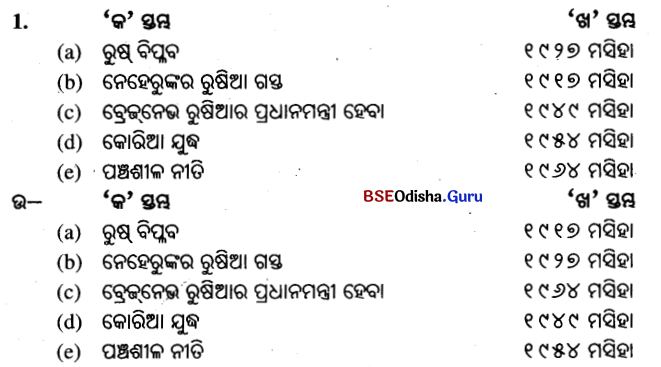
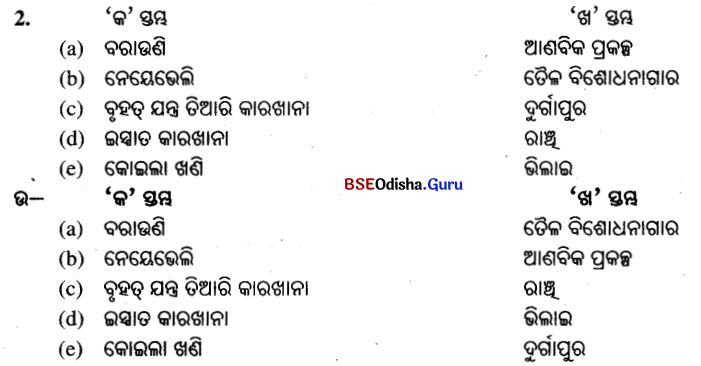
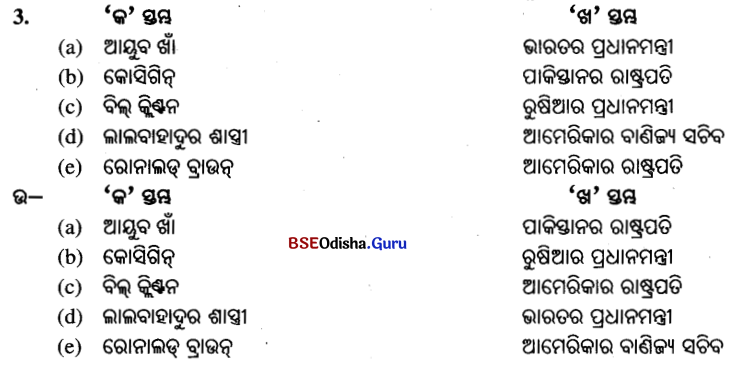
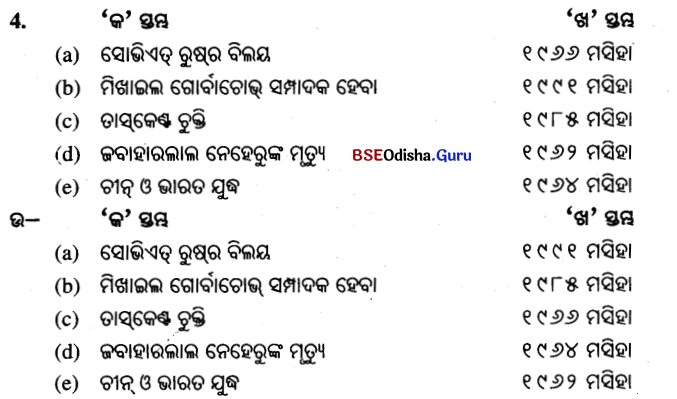
![]()
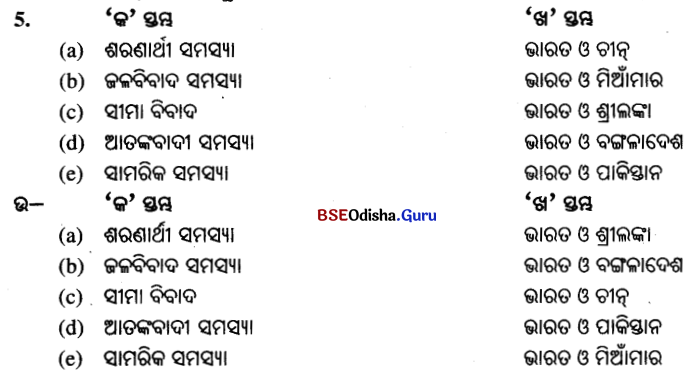
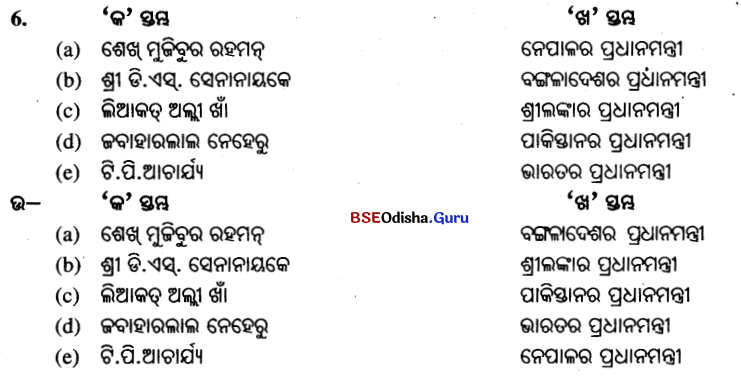
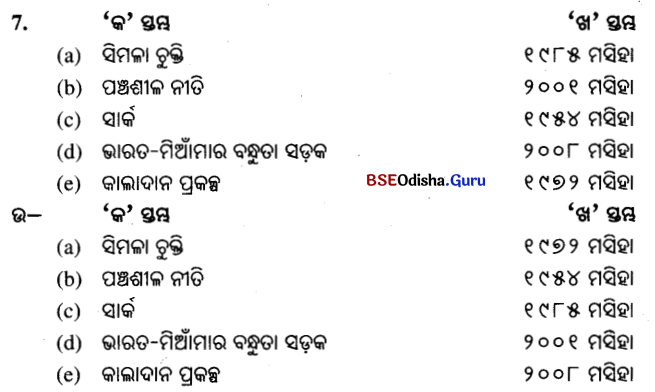
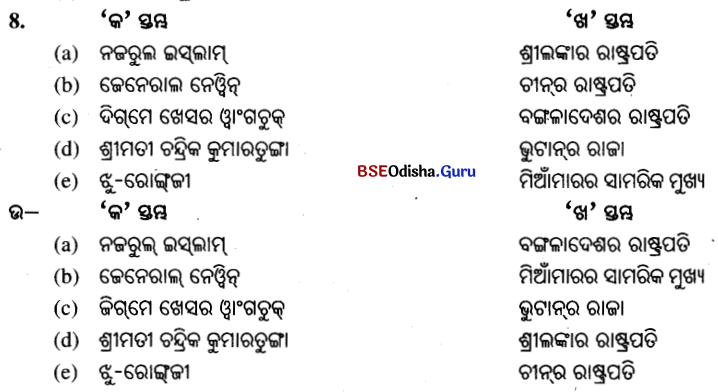

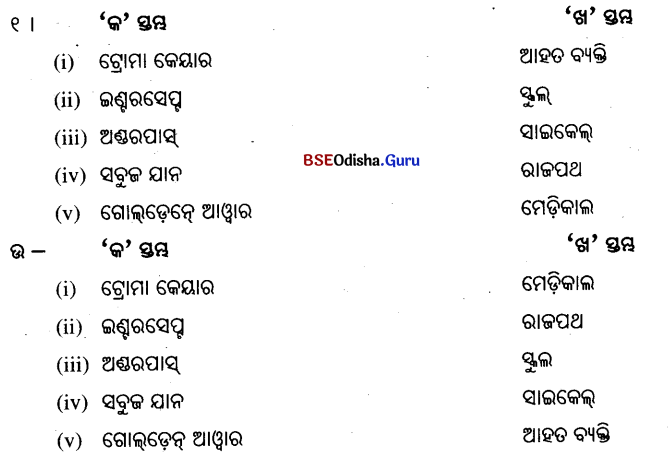
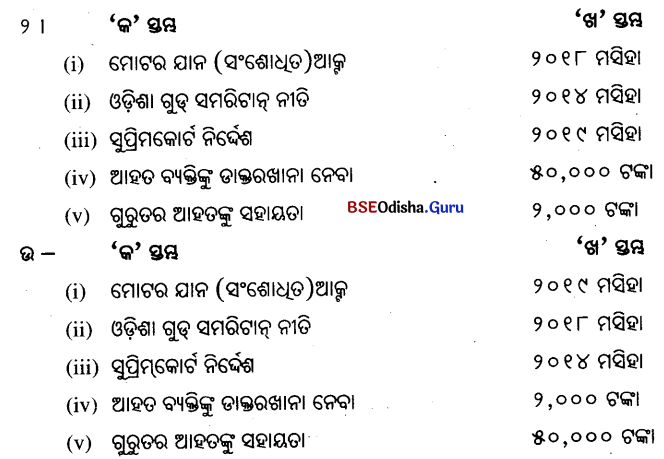
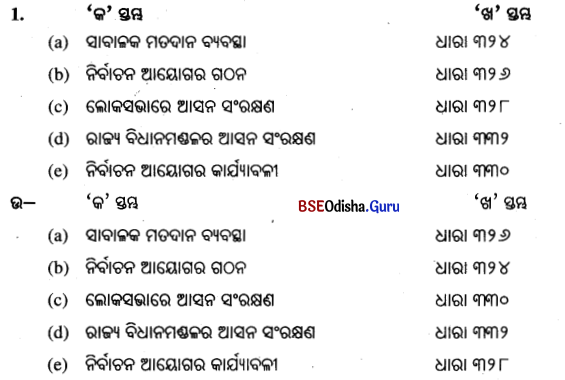
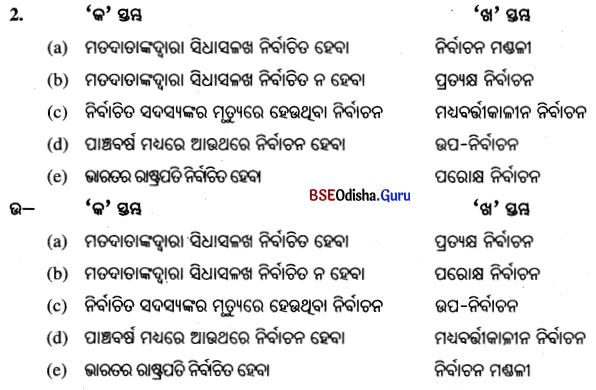

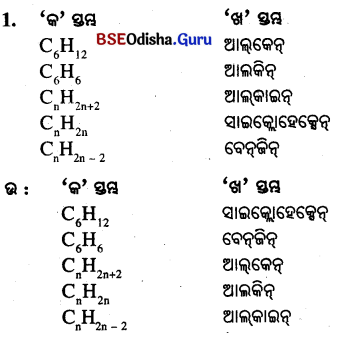
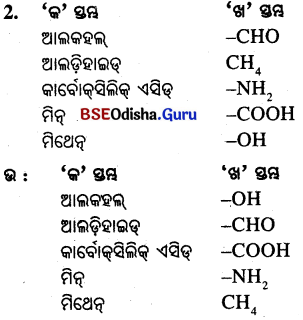

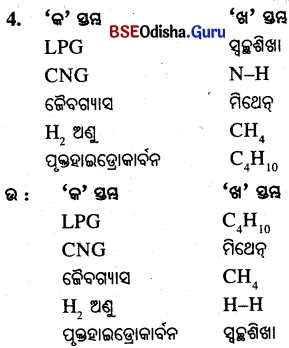

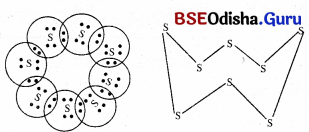

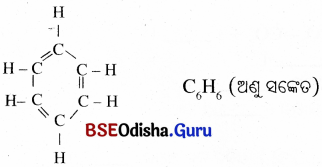
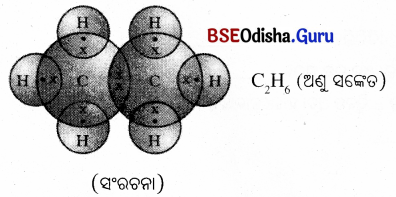
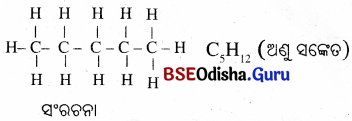
 : ………….
: ………….